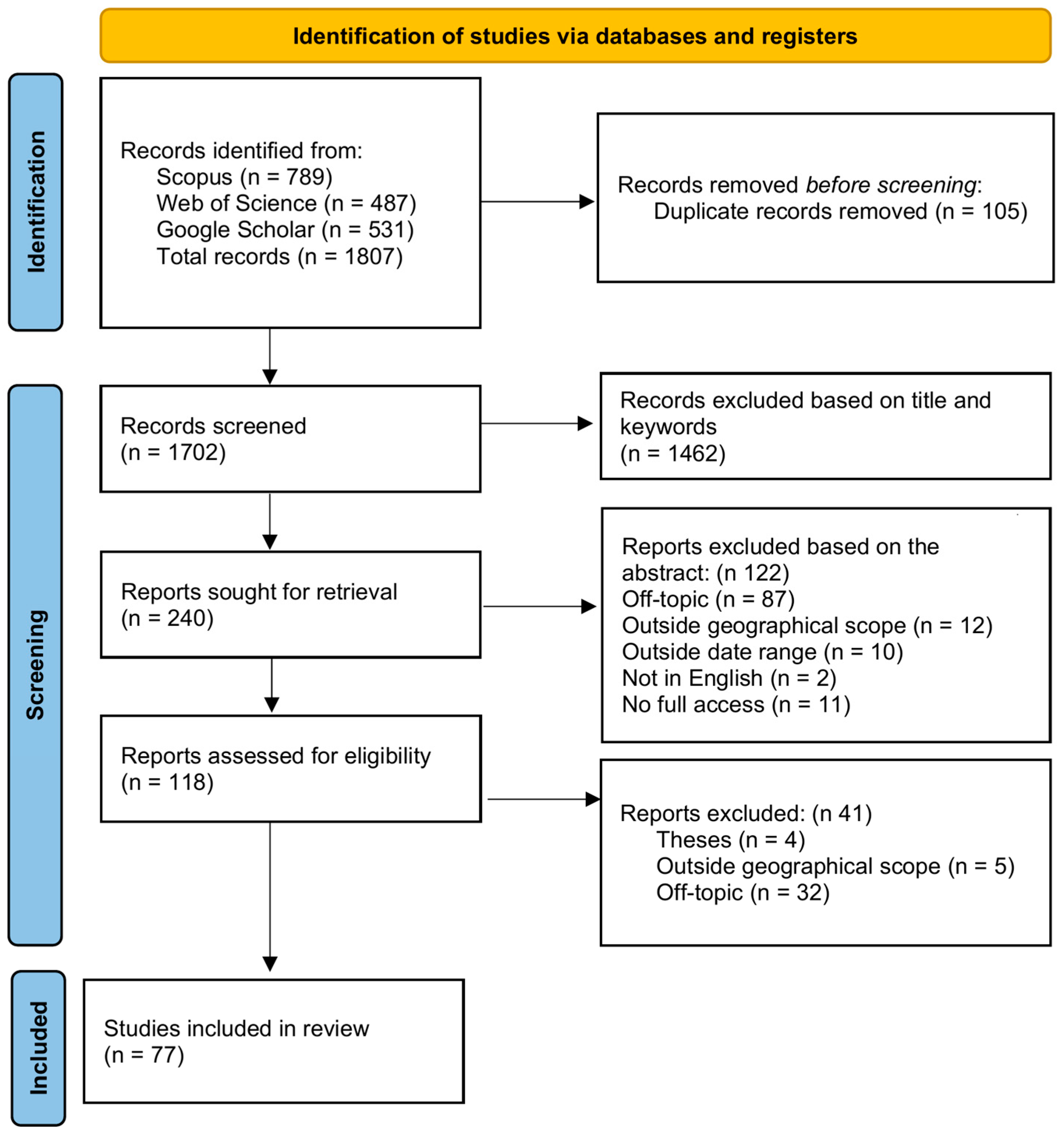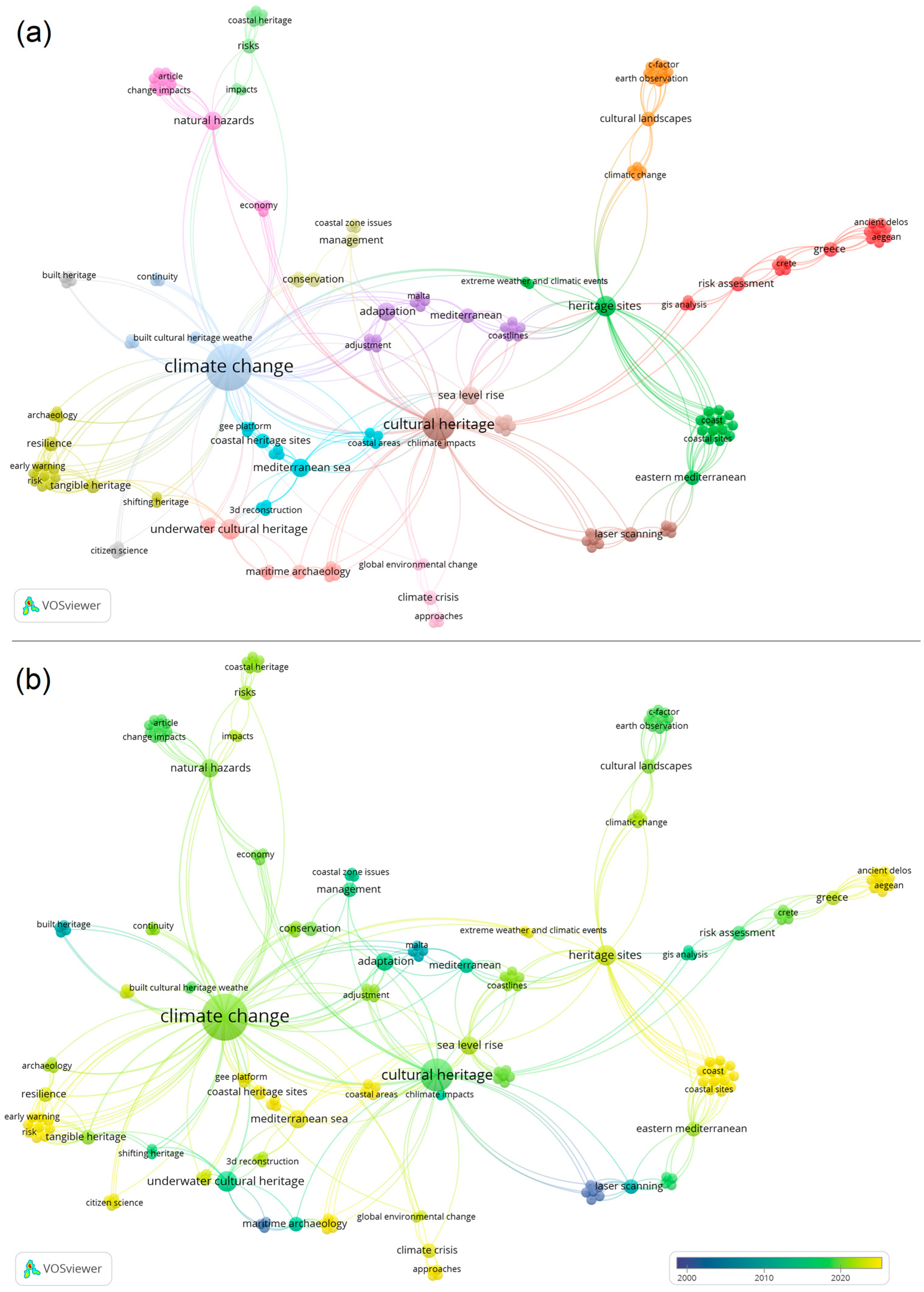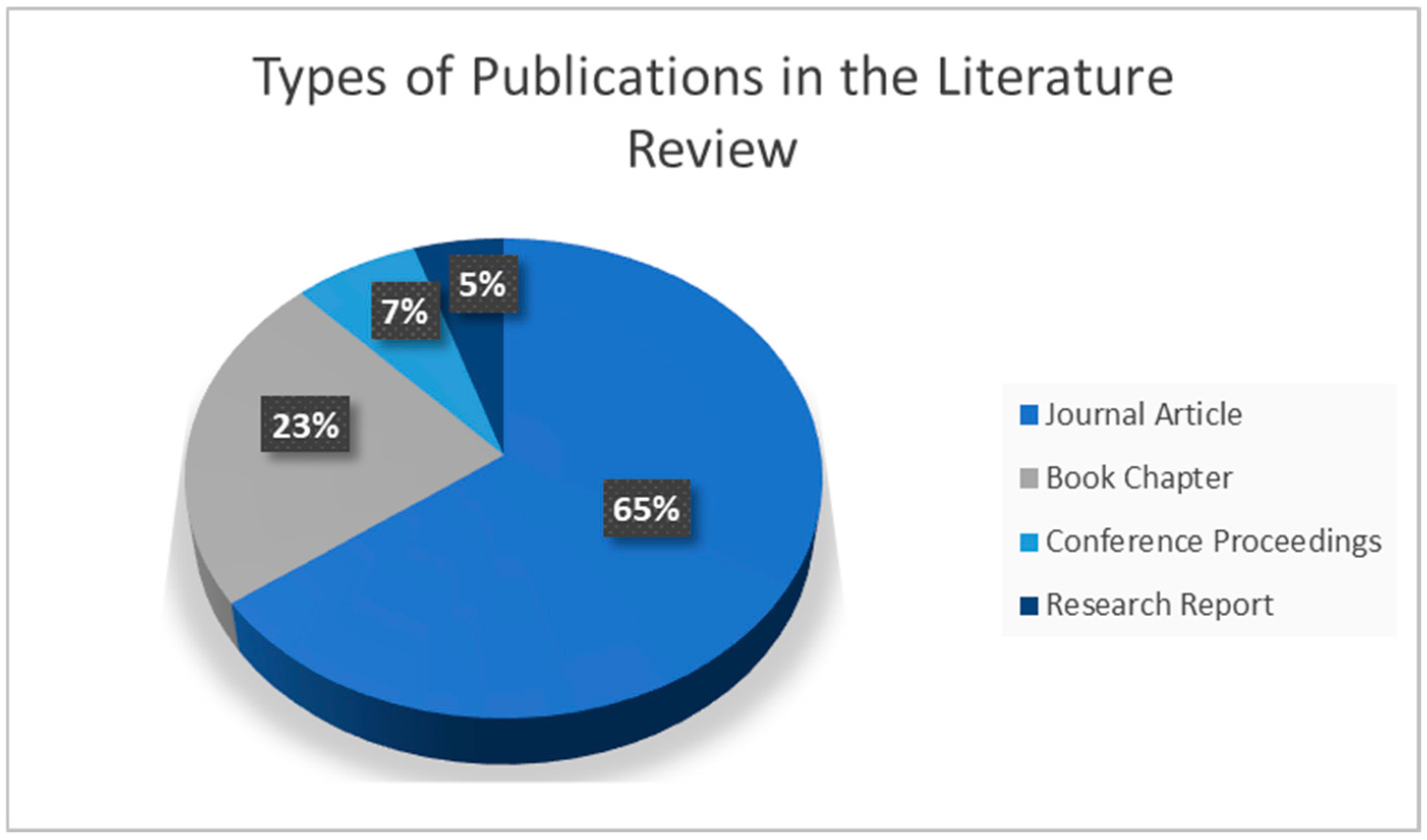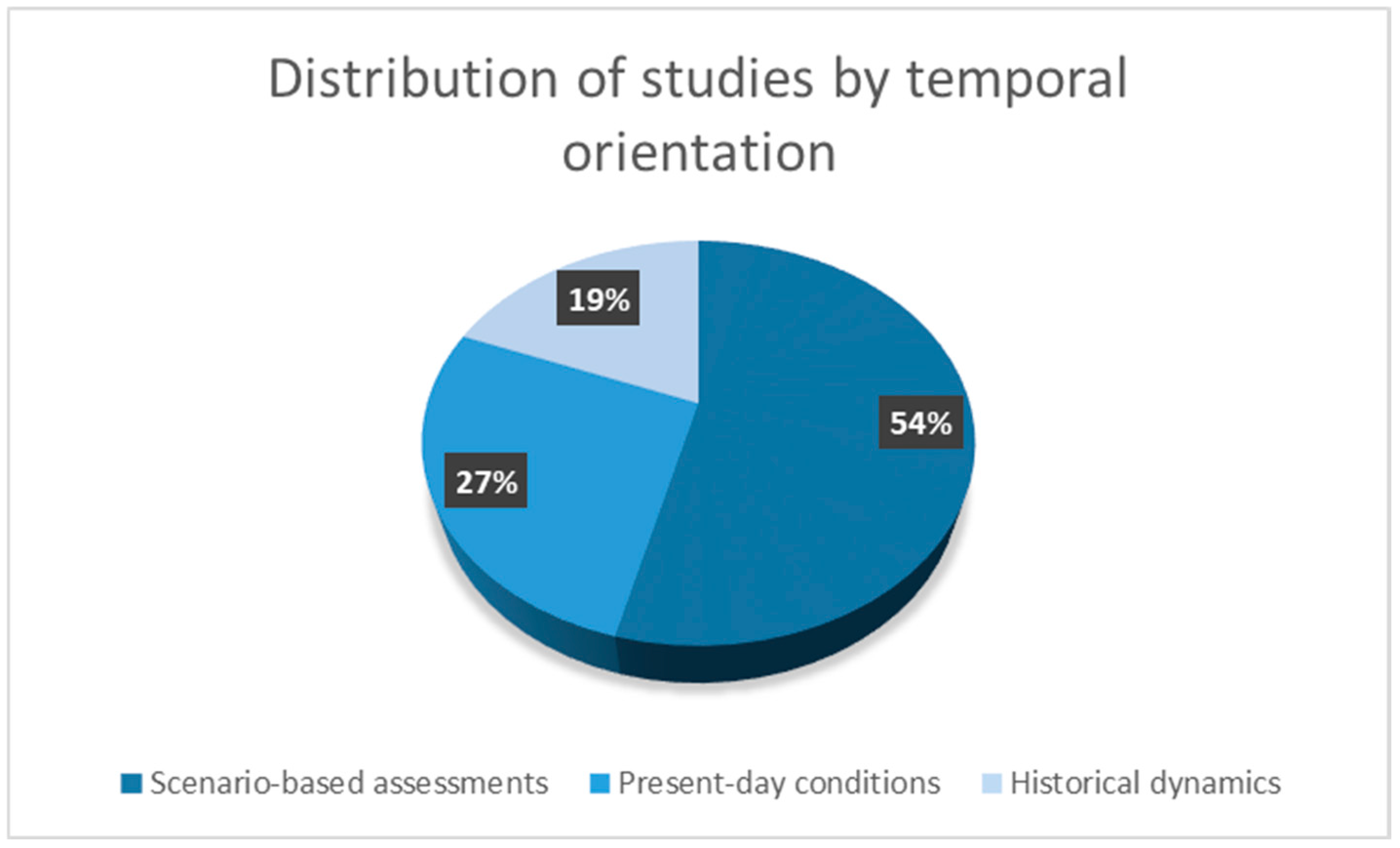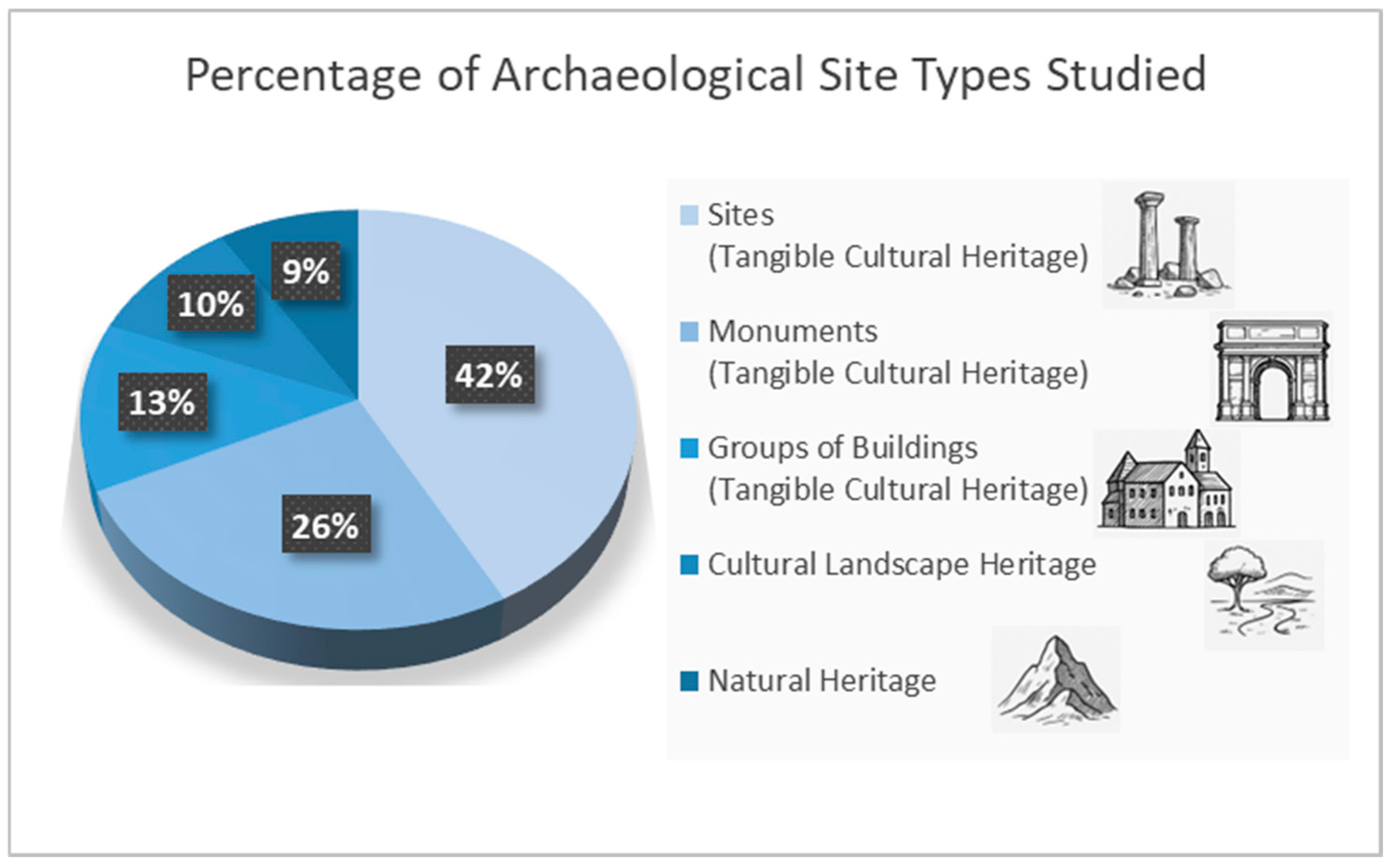1. Introduction
Cultural heritage, including archaeological sites, historic monuments, and cultural landscapes, represents an invaluable repository of human history, offering essential insights into past civilizations while fostering cultural identity, education, and sustainable tourism [
1,
2]. Within this broader context, the Mediterranean basin, widely recognized as the “cradle” of numerous civilizations, hosts coastal cultural heritage of exceptional historical, cultural, and socio-economic significance [
2,
3]. These landscapes not only preserve tangible evidence of human interaction with the sea but also contribute to scientific research, knowledge transfer, and public engagement, strengthening the link between past and present [
2,
4,
5].
Following UNESCO and ICOMOS definitions, archaeological sites encompass locations with material remains of past human activity, whether on land or underwater, often preserving stratified evidence of settlement, ritual, or trade. Monuments are individual architectural works or sculptural creations of historical, artistic, or scientific value, while groups of buildings constitute coherent ensembles such as historic quarters, monasteries, or fortified complexes, whose cultural significance derives both from the structures themselves and their spatial arrangement. Cultural landscapes illustrate the combined works of nature and humankind, including agricultural terraces, coastal fishing areas, or sacred seascapes, reflecting the evolution of societies over time. Finally, natural heritage refers to natural features, formations, and areas of outstanding universal value that intersect with human history and identity [
6,
7,
8]. In this study, the focus is placed exclusively on coastal cultural heritage. Mentions of natural heritage or environmental processes are retained only where they are part of the reviewed studies or directly affect the preservation, exposure, and management of cultural assets in coastal zones. Accordingly, natural heritage is considered a contextual element within the analyzed literature rather than a separate subject of investigation.
These assets are increasingly threatened by the combined effects of natural and anthropogenic pressures, with climate change acting as a major accelerant. Gradual changes in temperature, precipitation patterns, humidity, wind intensity, and most critically, Sea-Level Rise (SLR) are reshaping the environmental conditions of heritage sites [
9,
10,
11]. In the Mediterranean, SLR is projected to exceed 25 cm by 2050, with particularly severe impacts in the Eastern Mediterranean [
11,
12]. Such trends heighten the occurrence and intensity of storm surges, flooding, and coastal erosion, increasing the likelihood of irreversible structural damage and loss of cultural assets [
13,
14]. In this context, the preservation of coastal cultural heritage has emerged as a pressing global challenge.
The impacts are already visible. Iconic cultural heritage sites such as Alexandria in Egypt, Carthage in Tunisia, Venice in Italy, Tarraco in Spain, and the Greek island of Delos are experiencing shoreline retreat and inundation risks [
3,
15]. Material degradation processes, such as salt crystallization within porous building materials and biological damage to submerged wooden structures, compromise both structural stability and long-term preservation [
16,
17]. While hard engineering solutions such as seawalls and breakwaters are deployed in some areas, they can inadvertently exacerbate erosion in adjacent zones [
14,
18].
Given these challenges, research on Mediterranean coastal cultural heritage has expanded, yet significant disparities remain. Certain regions, including parts of the Middle East, North Africa, and smaller Mediterranean countries, lack comprehensive baseline data on site condition, exposure, and vulnerability [
19,
20]. Addressing these knowledge gaps requires systematic assessment methodologies and advanced monitoring tools. Technologies such as Geographic Information Systems (GIS), remote sensing, flood modelling, photogrammetry, and use of drones provide effective, cost-efficient means for documenting site conditions, mapping vulnerabilities, and supporting predictive modelling for proactive management [
21,
22,
23]. Previous work has already reviewed the vulnerability of Mediterranean coastal cultural heritage in the context of climate adaptation, emphasizing the use of GIS, remote sensing, and flood modelling, and highlighting research disparities across different regions [
24].
This study aims to conduct a systematic bibliographic review of research on Mediterranean coastal cultural heritage published between 2000 and 2024. The purpose is to trace the evolution of scholarly interest over the past two decades, examine the methodological approaches most frequently employed, and identify the types of archaeological sites and geographic regions that have been prioritized in academic investigations. By applying PRISMA guidelines and combining bibliometric and spatial analyses, the study seeks to map research trends, highlight thematic and regional disparities, and assess the extent of interdisciplinary collaboration. Particular attention is given to the technological tools and conservation methods most commonly adopted to evaluate their role in monitoring, protecting, and managing coastal cultural heritage under the pressures of climate change. Ultimately, this study intends to reveal critical gaps in the existing literature and provide a solid foundation for future research directions and policy strategies aimed at safeguarding the cultural, social, and economic values of Mediterranean coastal cultural heritage.
2. Materials and Methods
This study conducted a systematic literature review focused on coastal cultural heritage in the Mediterranean region. The review followed the PRISMA 2020 guidelines [
25], ensuring a rigorous, transparent, and replicable methodology for identifying and analyzing relevant academic literature. The PRISMA framework supported the structured refinement and filtering of records, enhancing the reliability and reproducibility of the results [
26,
27].
The review process is illustrated in the research framework (
Figure 1), which outlines the selection and exclusion criteria. This visualization is a central component of the PRISMA methodology, as it clearly summarizes how the initial pool of 1807 records was progressively refined to the final set of 77 publications included in the analysis. The initial database search was conducted across three major academic platforms: Scopus (
n = 789), Web of Science (
n = 487), and Google Scholar (
n = 531), yielding a combined total of 1807 records. After removing 105 duplicates, 1702 unique entries remained. A preliminary screening based on titles and abstracts excluded 1462 records that were outside the scope of the study. The remaining 240 articles were evaluated for eligibility through abstract-level assessment, which led to the exclusion of an additional 122 studies for the following reasons: thematic irrelevance (
n = 87), non-Mediterranean geographic focus (
n = 12), publication outside the target timeframe (
n = 10), non-English language (
n = 2), and lack of access to full text (
n = 11). These non-English works and studies unrelated to the Mediterranean were systematically excluded to maintain consistency and comparability.
Of the 118 full-text articles retrieved, 41 were excluded upon closer examination due to being theses (n = 4), having a non-Mediterranean focus (n = 5), or lacking thematic relevance (n = 32). As a result, a total of 77 publications met all inclusion criteria and were retained for full analysis. While the review prioritized peer-reviewed journal articles, relevant book chapters were also included, as they frequently offer critical insights into region-specific practices and case studies that are not always covered in academic journals.
The scope of the review was restricted to literature published between 2000 and 2024, capturing over two decades of scholarly output and research evolution in the field. A structured keyword strategy using Boolean operators guided the literature search. Keywords were selected to reflect the major research themes and included: (i) Mediterranean, (ii) Coastal Heritage Sites, (iii) Coastal Archaeological Sites, (iv) Climate Change, (v) Sea-Level Rise, (vi) Coastal Vulnerability, (vii) Climate Adaptation, (viii) GIS, and (ix) Risk Assessment (
Table 1). This approach facilitated a comprehensive yet focused retrieval of literature relevant to the study objectives, while minimizing irrelevant entries.
Based on the selected publications, bibliometric and visualization techniques were applied to analyze patterns and trends in the literature. To support data analysis and visualization, VOSviewer (version 1.6.19) was employed (
Figure 2a,b). This software facilitated bibliometric mapping, allowing for the identification of co-authorship patterns, keyword co-occurrence, and citation networks across the selected literature. In this study, a keyword co-occurrence network of the reviewed literature was generated, alongside a temporal overlay visualization to track keyword trends over the period 2000–2024. These analyses facilitated the identification of thematic clusters, emerging research trends, and patterns of international cooperation within the field.
3. Results
A total of 77 studies were included in this systematic review, focusing on the vulnerability of Mediterranean coastal heritage sites to climate change impacts. The literature primarily addresses risks related to sea-level rise, coastal erosion, and extreme weather events, while also exploring implications for conservation and management. The following subsections present the main results, including thematic trends, methodological approaches, and regional patterns of research activity.
3.1. Thematic and Keyword Analysis
Figure 2a,b illustrate the thematic and temporal distribution of keywords. The keyword co-occurrence network (
Figure 2a) highlights two central hubs, climate change and cultural heritage, that are strongly connected to multiple thematic clusters. Frequently associated terms include natural hazards, sea-level rise, heritage sites, underwater cultural heritage, and risk assessment. Other clusters emphasize the increasing role of digital and technological approaches such as GIS, remote sensing, laser scanning, and 3D documentation, reflecting the methodological diversity of the field. The visualization demonstrates the strong interplay between environmental processes, archaeological perspectives, and technological tools in Mediterranean coastal heritage research.
The temporal overlay visualization (
Figure 2b) traces the evolution of keyword trends between 2000 and 2024. Early research (2000–2010, shaded in blue) was limited in scope and volume, focusing mainly on broad concepts such as climate change, cultural heritage, and sea-level rise. Keywords including maritime archaeology, maritime history, UNESCO, IMO, policy, and vulnerability also appear, reflecting initial involvement by international organizations and the first attempts to link heritage to governance and risk frameworks. During the intermediate phase (2010–2017, shaded in green), research expanded toward management and adaptation strategies. Keywords such as management, decision-making, conservation, adaptation, and resilience gained prominence, indicating a shift from impact-focused assessments to heritage governance and long-term safeguarding. More recent studies (2017 onward, shaded in yellow) emphasize digital innovation. Keywords such as photogrammetry, point cloud, 3D documentation, GIS analysis, early warning systems, and citizen science have become increasingly frequent, reflecting a turn toward technologically advanced tools for documentation, monitoring, and predictive modeling.
3.2. Types of Publications
Peer-reviewed journal articles dominate the corpus, comprising 65% of the publications, while book chapters account for 23%. Conference proceedings remain limited at 7%, and research reports are the least represented at 5%.
Figure 3 presents the distribution of these four publication types and demonstrates the predominance of peer-reviewed literature as the primary outlet for disseminating findings in this field, with alternative forms of scholarly production playing only a secondary role.
3.3. Case Studies Versus Generalized Research
A strong reliance on case study approaches characterizes the literature, with 71% of the reviewed works adopting a case study approach, while only 29% represent generalized or cross-regional analyses.
This indicates that empirical, context-specific investigations dominate the field, providing valuable in-depth insights but also highlighting a relative scarcity of generalized, comparative, or cross-regional analyses. These results indicate a clear predominance of peer-reviewed journal literature as the primary outlet for disseminating research on Mediterranean coastal heritage and climate change, with other forms of scholarly production remaining comparatively limited.
3.4. Temporal Orientation of Studies
The majority of the reviewed studies (54%) fall under scenario-based assessments, emphasizing projections and sea-level rise scenarios. Research focusing on present-day conditions accounts for 27% of the corpus, documenting the current state of coastal heritage and ongoing monitoring. Finally, 19% of the works examine historical dynamics, drawing on archaeological, historical, or palaeo-environmental data to reconstruct past changes.
Figure 4 summarizes this temporal distribution, showing the predominance of studies concerned with anticipating future developments compared to those addressing present realities or historical perspectives.
This distribution indicates that research in this field is primarily directed towards anticipating and addressing future developments, with fewer studies concentrated on documenting present realities or investigating historical perspectives.
3.5. Types of Archaeological and Heritage Sites
Τhe distribution of site types addressed in the reviewed studies is shown in
Figure 5. Particularly, the majority of publications focus on tangible cultural heritage, with archaeological sites representing 42% of the total, monuments 26%, and groups of buildings 13%. Cultural landscapes account for 10% of the sample, while natural heritage is the least represented at 9%.
It is important to note that natural heritage was not examined as an independent category in this review. Its presence in
Figure 5 reflects studies that considered both cultural and natural heritage aspects within the same research context (e.g., heritage landscapes or mixed cultural–natural sites). Accordingly, the analysis treats natural heritage as part of the contextual environment in which coastal cultural heritage is studied, rather than as a distinct subject of investigation. Taken together, sites, monuments, and groups of buildings constitute 81% of the reviewed literature, underscoring a clear emphasis on tangible cultural heritage.
3.6. Temporal Distribution of Publications
Figure 6 illustrates the annual distribution of publications between 2000 and 2024. No studies were recorded in 2000, while the first relevant works appeared in 2001. Publication activity remained very limited until 2007, with values close to 1%. A slight increase is observed in 2008–2010 (around 4%), followed by minor fluctuations between 2011 and 2016, generally within the range of 1–4%. From 2017 onwards, a clear upward trend emerges. The annual percentage of publications rises steadily, reaching 9–10% in 2019 and 2020. Although a decline is visible in 2021 (around 7%), activity stabilized at approximately 9% in 2022–2023. The highest peak occurs in 2024, when publication output surpasses 13%. These findings confirm that research on Mediterranean coastal heritage in relation to climate change is a relatively recent but rapidly expanding field, with most scholarly activity concentrated in the last decade.
Overall, the period 2000–2013 accounts for 26% of the publications, while 2014–2024 represents 74%. This comparison highlights the strong predominance of research output in the most recent decade, indicating a substantial increase in publication activity over time.
3.7. Spatial Distribution of Publications
The spatial distribution of reviewed studies by country is presented in
Figure 7. Italy emerges as the most frequently represented country, accounting for approximately 16% of the total publications. Greece and Cyprus follow, each contributing around 10%, while Egypt, Spain, Turkey, and Tunisia each account for 6–9%. Collectively, these seven countries represent more than 65% of all studies, demonstrating a strong regional concentration of research activity. By contrast, other Mediterranean countries, including Malta, Morocco, Israel, and France, record much lower percentages, typically below 5%. Countries such as Libya, Algeria, Albania, and Slovenia are represented only marginally, with values close to 1%.
This uneven distribution reflects a clear imbalance in the geographical coverage of research across the Mediterranean region, with several areas remaining substantially underrepresented in the existing literature.
3.8. Methodological Approaches
Figure 8 provides an overview of the methodological landscape, in which technologically driven approaches occupy a central position. Remote sensing and GIS approaches dominate the field, accounting for more than 25% of studies and highlighting the central role of spatial analysis and geoinformatics. Climate and environmental modelling represents around 20%, followed by document and policy analysis (17%). 3D digital documentation and visualization techniques account for 13%, while archaeological fieldwork and related approaches are less frequent (10%), along with geotechnical and geophysical investigations (7%).
Socioeconomic and participatory approaches are the least represented, at only 5% of the total. Overall, the results reveal a methodological landscape largely centered on technologically driven and data-intensive approaches, with comparatively fewer studies employing socially oriented or participatory methods.
4. Discussion
This systematic review confirms the accelerated growth of research on Mediterranean coastal heritage and climate change over the past decade, yet highlights persistent geographical, thematic, and methodological imbalances. The notable increase in scholarly output after 2014, especially from 2017 onwards, coincides with an evident shift in scientific interest. Keyword trend analysis reveals a transition from impact-centered research toward themes such as adaptation, resilience, governance, and community engagement, underscoring a maturing research agenda. This trajectory reflects a broader global recognition of climate change as a critical threat to cultural heritage, stimulated by frameworks like the Paris Agreement and UNESCO’s enhanced focus on heritage under climate stress [
3,
4]. Accelerated sea-level rise has been identified as a major threat to archaeological sites along the Atlantic coast of France [
28], further intensified by increasing anthropogenic activities that alter the surrounding environment. Similar risks have been documented for coastal heritage assets in the United Kingdom and Ireland, where coastal processes and flooding already pose significant challenges and are expected to worsen as a direct consequence of climate change [
29].
The exposure of low-lying coastal heritage sites across Africa to flooding and erosion under different greenhouse gas emission scenarios (moderate: RCP 4.5; high: RCP 8.5) has also been evaluated in [
30]. Projections indicate that by 2050 a very large proportion of both cultural and natural heritage sites will face heightened vulnerability due to sea-level rise and extreme coastal events. Although various management and adaptation strategies have been proposed, studies emphasize that public awareness and community engagement remain critical components for effective heritage protection [
30,
31]. Furthermore, an extensive global assessment presented in [
32] highlighted persistent regional disparities, including limitations in technical capacity, policy frameworks and financial resources, which hinder the development of a uniform and equitable protection strategy for cultural heritage sites worldwide.
Importantly, 74% of the studies selected for this review were published in the last ten years, affirming the field’s growing momentum. However, this surge also illustrates the reactive nature of the literature, with scholarly attention intensifying only after the risks became widely acknowledged. Despite this expansion, significant gaps persist. Geographic representation remains skewed, with a predominant focus on Italy, Greece, and Cyprus, while North Africa and parts of the Eastern Mediterranean are markedly underrepresented even though sites in these regions, such as Libya and the Nile Delta, are demonstrably vulnerable to sea-level rise and erosion [
33,
34,
35]. These underexplored areas lack foundational baseline data and threat assessments, which are essential for prioritizing conservation interventions [
19,
36].
The dominance of archaeological sites (42%) and monuments (26%) in the reviewed literature reveals a pronounced typological bias toward tangible heritage, often at the expense of cultural landscapes and natural heritage systems. While this focus on iconic, material assets is understandable, it risks overlooking more dynamic interactions between human societies and their environments, which are essential for long-term resilience studies [
1,
4]. From a methodological perspective, research on Mediterranean coastal heritage and climate change is strongly oriented toward technologically driven approaches, particularly remote sensing, GIS, 3D documentation, and predictive modeling. These tools have considerably advanced the capacity for monitoring and scenario analysis, yet socially grounded and participatory methods remain marginal, appearing in less than 5% of the studies despite their acknowledged importance for building effective adaptation strategies [
19,
37,
38].
A similar imbalance is evident in research design, where over 70% of the literature adopts case study frameworks. While case studies provide indispensable context-specific insights, their predominance constrains the development of comparative and generalizable approaches that are essential for cross-regional coordination and policy formulation. Temporal orientation further reflects this asymmetry: although 54% of the studies concentrate on future scenarios, only 27% examine present-day conditions. The relative neglect of ongoing impacts perpetuates a critical knowledge gap, particularly acute in high-risk contexts such as Gaza and Morocco, and limits the evidence base needed to establish robust conservation priorities [
19,
33,
39]. Moreover, the review confirms that archaeological site categorization has increasingly been structured based on their specific characteristics, such as exposure to environmental stressors, proximity to the sea, and elevation, which inform vulnerability assessment frameworks. These typological distinctions help prioritize adaptation responses based on risk intensity, heritage significance, and feasibility of intervention [
40].
Crucially, the study identifies a persistent knowledge gap concerning present-day monitoring and baseline documentation, particularly for coastal heritage in low-resource or politically complex regions. The lack of such data continues to hinder the development of informed management strategies and leaves many vulnerable sites undocumented and unprotected [
19,
33]. Notably, over 70% of studies reported salinity or salt-related degradation as a significant threat, especially in highly saline environments such as Cyprus and Libya [
39,
41]. This widespread occurrence suggests that salt crystallization may be a regionally underestimated driver of heritage deterioration and requires further investigation. In light of these observations, the present analysis advocates for a more balanced and integrative research agenda, one that fills regional and thematic gaps, strengthens present-oriented data collection, incorporates social and participatory dimensions, and promotes comparative frameworks. Most urgently, addressing the lack of baseline data for coastal archaeological sites in regions like the MENA (Middle East and North Africa) area must become a priority [
19,
33]. Bridging this gap will not only enhance the understanding of climate impacts on heritage but could also catalyze future research directions centered on proactive conservation and long-term resilience planning. Equally important is the establishment of a sustained, evidence-based monitoring framework that complements scenario-driven modelling and provides robust baselines for assessing the ongoing impacts of climatic and environmental change. Future research should therefore focus on developing an integrated and adaptive vulnerability assessment system capable of quantifying the exposure, sensitivity, and adaptive capacity of coastal archaeological sites under current and projected stressors. This framework should integrate spatial analyses, environmental diagnostics, and socio-institutional variables within a dynamic, data-driven platform, enabling continuous observation, early warning, and the prioritization of conservation measures.
Moreover, the incorporation of participatory and community-based approaches is essential to link scientific evaluation with local knowledge, governance mechanisms, and cultural values. Embedding these social dimensions within technical assessments would transform vulnerability analysis from a descriptive exercise into a proactive tool for adaptation planning and evidence-based decision-making. In this context, advancing research on Mediterranean coastal cultural heritage will require strengthening cross-regional collaboration, ensuring data interoperability and transparency, and integrating heritage preservation within comprehensive frameworks for climate resilience and sustainable coastal management across the region.
5. Conclusions
This review highlights the growing academic engagement with the impacts of climate change on Mediterranean coastal heritage, alongside a series of enduring limitations that hinder the development of a cohesive and applied research agenda. Although scholarly output has increased substantially over the past decade, particularly after 2017, this growth has not translated into balanced coverage in spatial, methodological, or temporal terms. A limited concentration of case studies in specific countries, the predominance of technology-driven methodologies, and a strong focus on future scenarios collectively restrict the ability to generalize findings or support effective, region-wide adaptation strategies [
4,
33,
37].
Thematic trends in the literature further reflect this imbalance. Tangible heritage, especially archaeological sites and monumental architecture, remains the central focus of most studies, while cultural landscapes, natural heritage, and intangible heritage receive comparatively limited attention [
1,
19]. At the same time, although tools such as GIS, remote sensing, and 3D modelling have greatly enhanced monitoring capacities [
42], socially embedded methodologies, such as participatory assessments, community engagement, and local governance integration, remain strikingly scarce. Their limited application weakens the social relevance and adaptive capacity of heritage management frameworks, particularly in contexts of high risk [
37,
38].
One of the most critical gaps identified is the lack of present-oriented research. More than half of the reviewed studies focus on projections for 2050 and beyond, while only a small subset documents the current condition of heritage sites or provides baseline research. This temporal imbalance constrains the ability to prioritize conservation actions or respond to ongoing degradation [
19,
33]. The frequent reporting of salt-related deterioration, identified in over 70% of the studies, further underscores the need for standardized integration of environmental stressors such as salinity into vulnerability assessment models [
39,
41].
Taken together, these observations point not only to gaps in current knowledge but also to promising directions for future research. The identified absence of empirical, present-focused, and participatory studies highlights the need for interdisciplinary approaches that integrate environmental diagnostics with socio-institutional realities. Addressing these deficits can enable the development of robust, adaptive, and context-specific strategies that will support the long-term resilience of coastal heritage in the face of accelerating climate change. Future work will pursue this direction by developing an integrated assessment framework capable of evaluating coastal vulnerability at both the site-specific and regional scales. By incorporating multiple variables into a unified model, this research aims to generate systematic insights that bridge environmental processes with heritage management priorities, thereby contributing to more evidence-based and anticipatory conservation planning.
